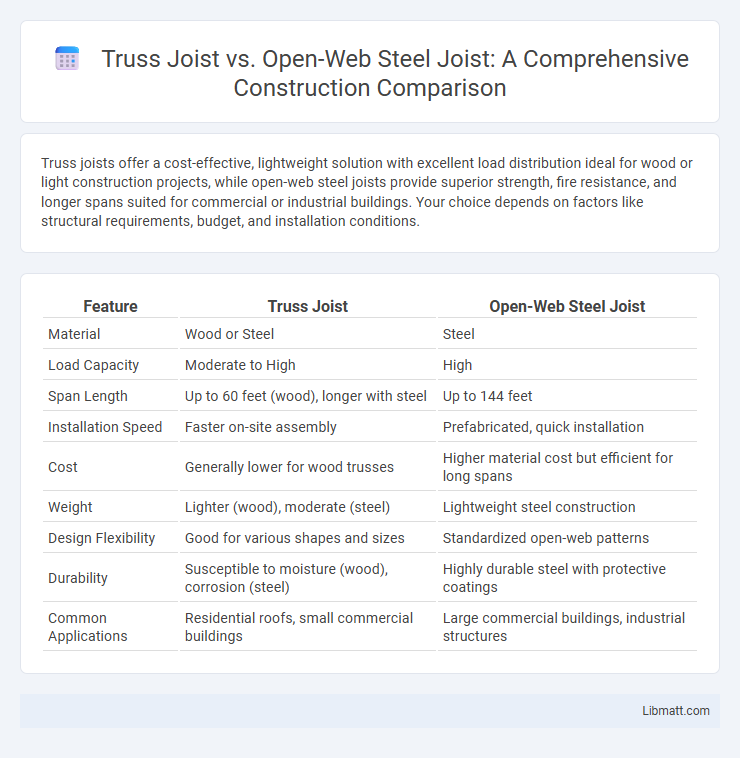Truss joists offer a cost-effective, lightweight solution with excellent load distribution ideal for wood or light construction projects, while open-web steel joists provide superior strength, fire resistance, and longer spans suited for commercial or industrial buildings. Your choice depends on factors like structural requirements, budget, and installation conditions.
Table of Comparison
| Feature | Truss Joist | Open-Web Steel Joist |
|---|---|---|
| Material | Wood or Steel | Steel |
| Load Capacity | Moderate to High | High |
| Span Length | Up to 60 feet (wood), longer with steel | Up to 144 feet |
| Installation Speed | Faster on-site assembly | Prefabricated, quick installation |
| Cost | Generally lower for wood trusses | Higher material cost but efficient for long spans |
| Weight | Lighter (wood), moderate (steel) | Lightweight steel construction |
| Design Flexibility | Good for various shapes and sizes | Standardized open-web patterns |
| Durability | Susceptible to moisture (wood), corrosion (steel) | Highly durable steel with protective coatings |
| Common Applications | Residential roofs, small commercial buildings | Large commercial buildings, industrial structures |
Introduction to Truss Joists and Open-Web Steel Joists
Truss joists are engineered wood or steel components designed with interconnected triangles to provide strong, lightweight support for floors and roofs. Open-web steel joists consist of parallel steel chords connected by a lattice of diagonal steel bars, offering high strength and long-span capabilities for commercial and industrial buildings. When selecting joists for your construction project, consider factors like load capacity, span requirements, and material preferences for optimal structural performance.
Structural Design Differences
Truss joists consist of timber or steel members arranged in triangular units, providing high strength-to-weight ratios and efficient load distribution through tension and compression. Open-web steel joists feature lightweight steel sections with open, web-like patterns that allow for longer spans and easier integration of mechanical systems while maintaining structural integrity. The key design difference lies in material selection and web configuration, where truss joists offer flexibility in timber applications and open-web steel joists optimize steel usage for commercial and industrial building frameworks.
Material Composition and Sustainability
Truss joists are primarily made from engineered wood, offering renewable and biodegradable advantages that align with sustainable building practices. Open-web steel joists utilize high-strength steel, which is highly recyclable and often contains a significant percentage of recycled content, reducing environmental impact. Your choice between wood and steel joists should consider factors like carbon footprint, resource renewability, and recyclability to support sustainable construction goals.
Load-Bearing Capabilities
Truss joists, typically constructed from wood or light steel, offer superior load-bearing capabilities for residential and light commercial applications due to their triangular web configuration distributing weight efficiently. Open-web steel joists, made from high-strength steel, provide greater span capacity and support heavier loads, making them ideal for large industrial or commercial buildings. The choice between truss joist and open-web steel joist depends largely on the required span length, load demands, and structural design specifications.
Span Length and Flexibility
Truss joists typically offer longer span lengths up to 60 feet, making them ideal for residential and light commercial buildings requiring flexible interior layouts without intermediate supports. Open-web steel joists can achieve even greater spans, often exceeding 90 feet, providing superior load-carrying capacity and flexibility for large industrial or commercial structures. Your choice depends on project requirements, with steel joists favored for maximizing open space and truss joists suited for moderate spans with adaptable design options.
Installation Process and Speed
Truss joists typically feature a lightweight wood framework that allows for easier handling and faster installation on-site compared to open-web steel joists, which require specialized equipment and skilled labor due to their heavier steel components. The installation speed of truss joists can reduce overall construction time, benefiting projects with tight schedules. Your choice between the two should consider the availability of resources and the complexity of the structure to optimize efficiency.
Cost Comparison: Truss Joist vs Open-Web Steel Joist
Truss joists typically cost less than open-web steel joists due to the use of more affordable materials like wood and simpler manufacturing processes. Open-web steel joists offer higher strength and longer spans but come with increased expenses related to steel production and specialized installation requirements. Your choice depends on budget constraints and structural demands, with truss joists providing a cost-effective solution for lighter loads and shorter spans.
Fire Resistance and Safety Considerations
Open-web steel joists offer superior fire resistance compared to traditional wood truss joists because steel is non-combustible and does not contribute to fire spread. Steel joists maintain structural integrity longer under fire conditions, enhancing building safety and reducing evacuation risks. Your choice of steel joists can improve overall fire safety measures and compliance with stringent building codes.
Applications in Residential and Commercial Construction
Truss joists are widely used in residential construction due to their lightweight nature and ability to span large distances, providing strong support for floors and roofs while allowing for easier installation of plumbing and electrical systems. Open-web steel joists dominate commercial construction where higher load capacities and fire resistance are critical, supporting heavier ceilings, HVAC systems, and long-span roof structures in warehouses, office buildings, and industrial facilities. Both joist types optimize structural efficiency but their selection depends on specific project requirements such as load demands, building codes, and architectural design.
Choosing the Right Joist System for Your Project
Selecting between a truss joist and an open-web steel joist depends on the project's load requirements, span length, and design flexibility. Truss joists, made from wood or steel, provide strong support for longer spans and are ideal for residential or light commercial buildings due to their cost-effectiveness and ease of installation. Open-web steel joists offer higher strength-to-weight ratios and greater durability, making them suitable for industrial and large-scale commercial projects requiring heavy load-bearing capacity and long clear spans.
Truss joist vs open-web steel joist Infographic

 libmatt.com
libmatt.com